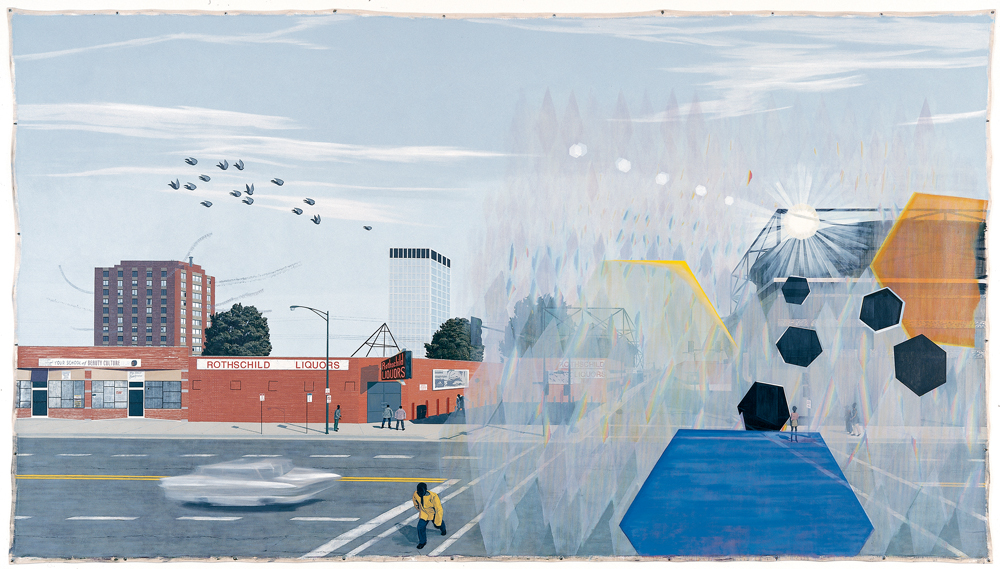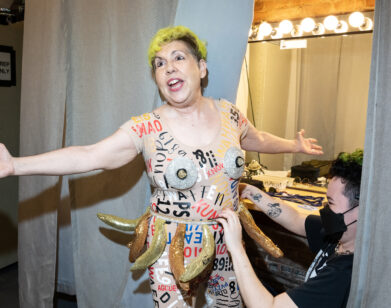Kerry James Marshall’s Mastry
Kerry James Marshall moved to Los Angeles with his family from Birmingham, Alabama in the 1960s, swept up by the Great Migration, like many other African-American families living in the Jim Crow south. Once on the West Coast, Marshall studied art and began a practice that would soon morph from collage into figurative painting. Now 60 years old and based in Chicago, the painter continues to draw inspiration from 20th century modernists, such as Romare Bearden, and the Civil Rights Movement. Tomorrow, his retrospective “Kerry James Marshall: Mastry” opens at the Museum of Contemporary Art Chicago before traveling to New York’s Metropolitan Museum of Art and MoCA L.A.
In 1980, after Marshall read Robert Vickery and Diane Cochrane’s New Techniques in Egg Tempera and Ralph Ellison’s Invisible Man, Marshall began working with tempera and created his first seminal work, A Portrait of the Artist as a Shadow of His Former Self. The painting depicts a black figure, dressed in a black suit and a black hat, against a flat black backdrop. The figure’s shirt, eyes, and teeth, which form into a grinning gap-tooth smile, are visibly white, while the rest of the man, depending on vantage point, is rendered nearly invisible. Although this work reflects Ellison’s writing as a black man in 1950s America (“I am invisible, understand, simply because people refuse to see me”), it simultaneously draws attention to widely accepted views of African-Americans and how African-Americans see themselves—two thematic references that resound throughout the artist’s 35-year figurative engagement with art history and an illustration of the fact that, put simply, black lives matter.
“Kerry James Marshall: Mastry” chronicles the evolution of Marshall’s portraiture, revealing why he has become one of the most important living artists of today. “I hew so closely and have committed to staying with the figure to demonstrate that there is a lot of room for exploration, that the field of representation, even in painting, is not completely exhausted yet,” the artist explains. Each of his series and individual works touches on a specific aspect or struggle of contemporary black life: the “Garden Project” series comments on the notion of black community; Self-Portrait of the Artist as a Super Model addresses the concept of black beauty; and BlackStar II and Watts reflect black protests.
Prior to the opening in Chicago, we spoke to the artist over the phone while he was at his studio.
ANTWAUN SARGENT: “Mastry” begins with your 1980 painting, Portrait of the Artist as a Shadow of His Former Self. Because it represents a shift from your earlier collage works to the mainstay of your concerns, looking back, does it feel like a manifesto of sorts?
KERRY JAMES MARSHALL: You can describe it as a manifesto of sorts. I saw it as a pivotal turn, a work that really led me down the avenues that brought me to where I am. That picture was the vehicle that helped me clarify a lot of things and I began to understand that I wanted to do. It became an instrument I could use to build a lot of things, which meant I was free to use other devices that helped me more fully articulate what I thought of the image in the first place. It was a way of demonstrating that there was a broad range of possibilities and fairly unlimited utility for a black figure that didn’t have to comprise its blackness in order to preserve a place in the field of representation.
SARGENT: Portrait of the Artist as a Shadow of His Former Self is executed in egg tempera, which was a technique employed in Renaissance paintings before the preeminence of oil painting. Was using that technique about elevating your point?
MARSHALL: Yeah. If you look at the image, it treads on a kind of popular stereotypical image of the black figure, in both its flatness and slightly comic edge. To take that image as a starting point and to render it in a proto-classical medium, like egg tempera, and then use a repertoire of classical compositional devices to make the picture was a way of setting up an engagement with art history. The amount of analytical energy that went into constructing the figure shows, on some level, that there is almost a complete contradiction of what the figure looks like. So it was a way of trying to enforce an intellectual engagement with the picture, as opposed to the tendency to read images like that in the folk art manner.
Artwork operates on two different levels: On one level there’s artwork as a mode of expressivity, and then there’s the other side, where the image is a construction that is meant to engage in a discursive field in order to preform a particular function. That’s the kind of work I am trying to get that image to do; I want people to understand that this is a very calibrated image, where point by point, very little is left to chance.
SARGENT: You’ve said that Invisible Man had a great effect on your early painting. In what ways did Ellison’s novel inform your understanding of 1980s politics?
MARSHALL: The condition of visibility as it relates to black people was crucial. Connected to that, I’ve always been interested in science fiction and horror films and was acutely aware of the political and social implications of Ralph Ellison’s description of invisibility as it relates to black people, as opposed to the kind of retinal invisibility that H.G. Wells described in his novel Invisible Man. In Ellison’s case, it’s more psychological than it is phenomenal, and it’s conditioned by anger, animosity, and lack of desire to engage with the black body. There was always simultaneity that had nothing to do with visuality. You can be there and not be there at the same time and be fully visible all the time. That’s what really struck me about Ellison and that’s what led me to start working with figures that were painted black—trying to find a way to embody that simultaneous presence and absence. What I preserved in the figures are those white eyes and white teeth, because that’s still connected to the way in which blackness, in the extreme, has been stigmatized and the way it was often joked that you couldn’t see black people in the dark until they had their eyes open or were smiling.
SARGENT: All the figures in your art are black, yet that blackness has been described as matte black, jet black, obsidian black, charcoal black, ebony black, and pitch black, among many others. How do you describe the color?
MARSHALL: There are a couple of ways that I approach it. When I started, I was aware of using the black as a rhetorical device. It’s understanding that black people come in a wide range of colors, but you find instances in a lot of black literature in which the blackness is used as a metaphor. In some places you can find an extreme blackness used as a descriptive. I also take into account historical realities that some of this range in color is the legacy of white supremacy. The privileged position of whiteness doesn’t allow for someone with one drop of Negro blood to be considered white, which allows whiteness to be a fairly pure category while blackness has to absorb an expansive reality of representation. Part of what I am dealing with, with this blackness, is asking the question, “Where are those black people, who are as dark as the description of a young black boy that Solomon Northup gives in 12 Years A Slave?” He describes the young black 14-year-old boy as “blacker than any crow.” You have to question if he is using that metaphorically or as a descriptive? You have to question, where are those black people? Part of the history of black people in the western hemisphere, in some ways, has been fleeing from this notion that they were black. So I can represent an ideal, and with that, you can demonstrate that there is nothing to be afraid of, nothing to run from, and that, in fact, a good deal of beauty that resides there.
SARGENT: Your use of the color black is also a conversation with 20th century abstraction. Black Painting, for example, is one way of exploring abstract notions of blackness through this ideal form.
MARSHALL: It’s forcing the issue of perception by rendering an image that is just at the edge of perception, which in someway forces you to look more closely and for you to adjust your vision so you can see in the dark. Abstraction and representation are supposed to be going down two very different paths, one sociological and the other aesthetic. The way I see it is if you’re going to deal with black representation, you also have to show that you can do two things at once. You can be completely invested in the image and also the idea of the aesthetic experience of the object.
SARGENT: Is that also your engagement with Renaissance painting in works like Untitled (Studio), where you see Paul Cézanne’s influence? Are you doing two things at once?
MARSHALL: Yeah, and sometimes I have three balls in the air at once. [laughs] I used to always say—and I think a lot of artists think of it this way—that when you see a black figure, the way the critical establishment operated, you can only imagine that figure having a sociological value. They never say the ways in which their aesthetics were equally worthy of consideration.
That was the thing that always kept black artists outside of the discourse—not whether the work was relevant, but was it engaged in the modernist and avant-garde practices white artists were engaged in? I think the approach that I’ve taken, which is fairly instrumental and strategic, is to deploy the principles that the people who theorized the value of artwork said were important. After 1958, you couldn’t come into the art world thinking you were going to be personally expressive. The permutation of what an artwork can be had been codified before I was even born, so my job is different; I came in making choices about how I deploy aesthetics and imagery strategically. It seems to me that’s the only legitimate way of making work.
SARGENT: In 2014, you created your Blot paintings. What drove you to abstraction after all these years?
MARSHALL: I don’t see those paintings as abstractions, especially because they are emblems of the inkblot. They aren’t smashed together; they are constructed shape-by-shape, layer-by-layer, like any other picture. The appearance is the allusion of abstraction when in fact I am in control of every aspect of that symmetry. What I was trying to construct was relative symmetry, where it seems clear that the shapes have arrived through consideration.
SARGENT: The idea of a western encyclopedic museum comes up in your work, particularly in the way that museums have maintained race as a naturalized category, and you get at that in Beauty Examined (1993). What do you think a museum should be in the 21st century?
MARSHALL: I think the museum should be an arena in which ideals can hash it out, fight it out, tooth and nail, for attention. The moment you introduce difference into a museum, then the privileged space is contested, and under the most ideal circumstances what all artists want is the chance to be competitive. That’s what I think the museum is supposed to be. Before people outside of the Western European tradition started asking to be in there, the people who were accumulating objects for the museum were perfectly satisfied with the narrative they were constructing. On some level, you can say that’s what they were supposed to do, and if we continue to let them, on some level that’s on us. No one has a right to occupy the privileged position all the time, so it should be contested. It should always be messy in there.
SARGENT: Your piece Rythm Mastr allows for narratives to be told in a different medium. What lead you to comics?
MARSHALL: Like a lot of young people who wanted to be artists, comics were a gateway for me. Comics were a place where captivating images lit your imagination and showed you that you can create new kinds of people and worlds. Comics also led a lot of young people to science fiction. But just like in the art museum, and notions of beauty and pleasure, if the hero is always a white guy with a squared jaw or pretty woman with big breasts, then kids start thinking that’s how it’s supposed to be. Part of the problem was that black comic book artists were making super heroes with the same pattern as the white super heroes. When you read a lot of those comics, the black super heroes don’t seem to have anything to do.
I just thought someone has to figure out how to break through that barrier and create a narrative for a black super hero story to unfold at the same scale as something like Star Wars. Rythm Mastr is about producing a narrative of a hero engaged in a struggle as complicated as those other stories. The catalyst for it was the beginning of the demolition of public housing in Chicago. When State Way Gardens and The Robert Taylor Homes were being torn down, it seemed like a perfect opportunity to use that as a backdrop for the development of a super hero narrative.
SARGENT: You’ve really placed black people and their experiences in the American museum. For example, in De Style, black figures are seen in the barbershop, a place that accurately reflects an important aspect of black culture.
MARSHALL: Since you mentioned the barbershop painting, there’s a beauty shop companion called School of Beauty, School of Culture at the Birmingham Museum of Art. I got an email that said a couple had a guerrilla wedding in front of that picture. They slipped into the museum with a preacher and had their wedding ceremony in front of it. It turns out that the woman is a beautician and the man is a barber, they had seen that picture, and they said it was the perfect place to get married.
SARGENT: The title of the show is “Mastry,” so what have you mastered in the last 35 years?
MARSHALL: [laughs] Nothing. No, you know, it’s a struggle from picture to picture to get it right. That’s one of the reasons I still make paintings and use the figure; it’s hard to do and hard to succeed. On some levels, because I am working with black figures and black pigment, it’s even harder because I have to be more responsible for the image. I try to be really careful about the presence the figure projects.
“KERRY JAMES MARSHALL: MASTRY” OPENS TOMORROW, APRIL 23, AT THE MUSEUM OF CONTEMPORARY ART CHICAGO.







